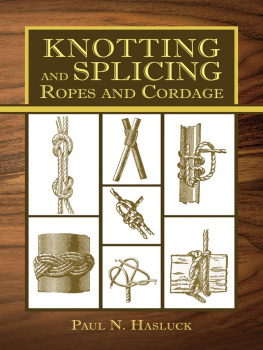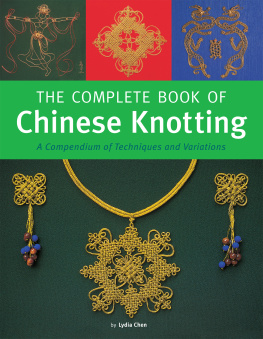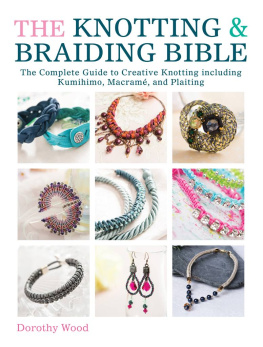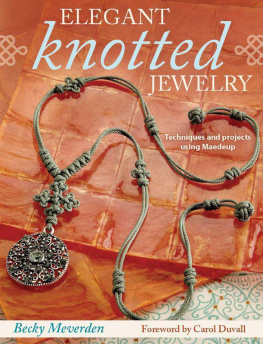Constantine A. Belash - Braiding and Knotting: Techniques and Projects
Here you can read online Constantine A. Belash - Braiding and Knotting: Techniques and Projects full text of the book (entire story) in english for free. Download pdf and epub, get meaning, cover and reviews about this ebook. year: 2013, publisher: Dover Publications, genre: Home and family. Description of the work, (preface) as well as reviews are available. Best literature library LitArk.com created for fans of good reading and offers a wide selection of genres:
Romance novel
Science fiction
Adventure
Detective
Science
History
Home and family
Prose
Art
Politics
Computer
Non-fiction
Religion
Business
Children
Humor
Choose a favorite category and find really read worthwhile books. Enjoy immersion in the world of imagination, feel the emotions of the characters or learn something new for yourself, make an fascinating discovery.

- Book:Braiding and Knotting: Techniques and Projects
- Author:
- Publisher:Dover Publications
- Genre:
- Year:2013
- Rating:5 / 5
- Favourites:Add to favourites
- Your mark:
- 100
- 1
- 2
- 3
- 4
- 5
Braiding and Knotting: Techniques and Projects: summary, description and annotation
We offer to read an annotation, description, summary or preface (depends on what the author of the book "Braiding and Knotting: Techniques and Projects" wrote himself). If you haven't found the necessary information about the book — write in the comments, we will try to find it.
Braiding and Knotting: Techniques and Projects — read online for free the complete book (whole text) full work
Below is the text of the book, divided by pages. System saving the place of the last page read, allows you to conveniently read the book "Braiding and Knotting: Techniques and Projects" online for free, without having to search again every time where you left off. Put a bookmark, and you can go to the page where you finished reading at any time.
Font size:
Interval:
Bookmark:
www.doverpublications.com
BRAIDING AND KNOTTING:
TECHNIQUES AND PROJECTS
BY
Constantine A. Belash
Illustrations by
CHARLES E. WHITE, JR.
DOVER PUBLICATIONS, INC.
NEW YORK
Published in Canada by General Publishing Company, Ltd., 30 Lesmill Road, Don Mills, Toronto, Ontario.
This Dover edition, first published in 1974, is an unabridged republication of the work originally published by the Beacon Press, Inc., in Boston, in 1936. The text has not been abridged, but a brief Foreword and Preface which appeared in the 1936 edition have been omitted in this Dover edition.
International Standard Book Number: 978-0-486-15612-5 Library of Congress Catalog Card Number: 74-75266
Manufactured in the United States of America
Dover Publications, Inc.
180 Varick Street
New York, N.Y. 10014
TABLE OF CONTENTS
Instinctive Use of Braiding; Materials for Braiding; Securing Braiding Strands; Preventing Tangling of Strands; Joining Strands; Tension for Braiding
Simplest Method of Flat Braiding; Variation of First Method; Braiding over One or More Double Strands; Braiding over One or More Triple Strands; Braiding with Double Working Strands; Braiding with Triple Working Strands; Dividing and Rejoining a Braid
One Strand Woven across Stationary Strands; Two Strands Woven across Together; Three Strands Woven across Together; Two Strands Woven across Alternately; Three Strands Woven across Successively; Four Strands Woven across Successively; Five Strands Woven across Successively; Three Strands Woven across to a Point on Each Side; Four Strands Woven across to a Point on Each Side
Oval Rug or Mat; Sandals of Tropical Fiber; Raffia Hat; Suede Leather Belt; Bracelet of Wide Gimp on Metal Band
Round Braiding; Round Braiding Attached to a Clip or over a Band; Three-Strand Solid Braiding; Spiral Braiding with Four Strands; Reversing the Spiral; Square Braiding with Four Strands; Square Braiding with a Finished End; Braiding with a Core; Lock Knot
Braided Bracelet on Metal Band; Boy Scouts Lanyard; Dog Leash
Origin of Knotting; Cords for Knotting; Square or Flat Knots; Spiral Square Knotting; Square Knotting over Cores of the Same Cord; Triple Knot; Half-Hitch Knot; Picot Tops; Collecting Knots; Chain Stitch; Buttonhole Stitches; Sennit Stitch; Bullion Stitch; Triangle Stitch; Square Stitch; Shell Knot; Chinese Knot; Double Carrick Bend; Turks Head
Shade or Electric Light Pull; Round Gimp Knotted Bracelets; Buttoned Bracelet; Belt; Knotted Bag
PART I BRAIDING
CHAPTER I
GENERAL DIRECTIONS FOR BRAIDING
Instinctive Use of Braiding
T HE process of braiding strands together, both for decorative effect and in order to obtain added strength, seems to have been one of mans earliest accomplishments. It may even have been that, through braiding, he was led to discover the more intricate art of weavingan art developed by all the earliest civilizations, thousands of years ago. Because of the perishableness of braiding materials and the fact that no tools are used in the process, there can be no historic evidence to substantiate this theory.
The process of braiding applied to the hair can be more definitely traced. It is known that both men and women of long-haired races used to braid their hair in remote prehistoric times, either in one or two wide plaits or, as in the case of the early Egyptians, in a great number of small, tight braids. In Greece, the earliest center of European culture, men were wearing their hair in elaborate arrangements in the sixth century B. c., but, under the influence of the unrivalled Greek sculptors of the fourth century, the custom was introduced for men to have their hair cut short. The Romans quickly adopted the Greek style and short hair for men was continued in Europe under the Roman Republic and Empire and through the Middle Ages. In the seventeenth century A. D., long hair again became fashionable for men and, by the year 1680, had led to the wearing of large braided and curled wigs by both men and women of the wealthy classes. England followed the fashion of the Continent and the British soldiers in the American Revolution almost all had long braids, which they larded and powdered or wore in eel skins. In the early part of the nineteenth century, the fashion was dropped.
In the periods when men have worn their hair long, they seem to have taken great pride in their braids and curls, the only exception being for the queues of the Chinese. Previous to the year 1644, Chinese men, and also their neighbors in Japan and Korea, were wearing their hair long and done in a knot at the back of the head. In that year, with the establishment of the Manchu dynasty as a result of a rebellion which overthrew the ruling Ming dynasty, there was introduced into China the odd style of the Manchus of shaving the front part of the head and allowing the rest of the hair to grow long, and braiding the long hair in a queue, lengthened, if need be, with black silk or false hair, to reach below the knee. The custom was not generally adopted by native Chinese until, in 1864, after a rebellion against Manchu authority had been suppressed, an edict was issued requiring all Chinese men to wear their hair in queues as a symbol of submission. It is recorded that more than a million men suffered themselves to be put to death rather than submit to the humiliation. The edict was kept in force until the revolution in 1912 and the establishment of the Chinese Republic, when it was immediately revoked and men were allowed to wear their hair short in the European and American fashion, which had already been adopted by the Japanese and Koreans. The Chinese queues furnish the only known example of braids being used as marks of disgrace.
This summary has been given in order to show how the braiding of hair, almost universally by women until within a few years and recurrently by men, has been an instinctive impulse of the human race. But even by primitive people braiding was also early applied to other materials, such as long native grasses and weeds, or strips of palm or banana leaves in Africa and the East Indies, which were braided together for strength or even made into baskets at a very early date. That the ornamental use of braiding was especially emphasized is shown in our language by the fact that the word braid is applied to any narrow decorative strip, whether or not made by the process of braiding. The various methods of braiding used today to give extra strength, for decorative purposes, and for making into articles, some of which have been known and practiced for many centuries, will be described in the following pages.
Materials for Braiding
Any material which can be made into strips and is flexible can be hand-braided. To the grasses and weeds already mentioned may be added an almost limitless list of suitable materials, such as string, cord, paper, cloth, leather, and even thin strips of metal. Different materials may even be braided together, or several strips of a fine material, like raffia, may be used together for each strand, but the strands should all be of the same thickness to make the braiding even. Various patterns and attractive effects can be obtained by using strands of different colors.
Securing Braiding Strands
The ends of strands should be fastened securely before the braid is started, so that they will not slip out of place. It is usually most convenient to tie the ends together with a piece of string, but it is often advisable to keep them flat. Strands of cloth or similar materials may be pinned separately onto a heavy cushion. The ends of strings or cords may be placed in position on a moistened strip of gummed paper, the gummed paper then folded over them and the covered ends inserted in a strong paper clip. This is the method which has been used for the illustrations of braids in the following chapters.
Next pageFont size:
Interval:
Bookmark:
Similar books «Braiding and Knotting: Techniques and Projects»
Look at similar books to Braiding and Knotting: Techniques and Projects. We have selected literature similar in name and meaning in the hope of providing readers with more options to find new, interesting, not yet read works.
Discussion, reviews of the book Braiding and Knotting: Techniques and Projects and just readers' own opinions. Leave your comments, write what you think about the work, its meaning or the main characters. Specify what exactly you liked and what you didn't like, and why you think so.








